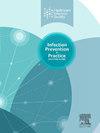儿科高级生命支持(PALS)中手部消毒的可行性:模拟研究
IF 1.9
Q3 INFECTIOUS DISEASES
引用次数: 0
摘要
背景由于手部消毒可能会延误挽救生命的治疗,因此在紧急情况下往往会省略手部消毒。由于医疗相关感染会严重恶化患者的预后,因此应重新评估在紧急情况下绝对不进行手部消毒的做法。对这一问题的实际观察初步表明,符合率为 10%。我们曾在一项成人模拟研究中表明,在不耽误患者护理的情况下进行适当的手部消毒在 50%的情况下是可行的。这项观察性研究旨在评估在需要高级生命支持(PALS)的模拟儿科患者中进行手部消毒的可行性。两名观察员根据世界卫生组织的规程统计了所有可能的手部卫生实施时刻,并对其进行了时间中立可行性评估。结果 在 32 个场景中,世界卫生组织所有时刻的手部消毒可行性从 78.3% 到 100% 不等。在所有 573 个手消毒时刻中,有 552 个(96.3%)被认为是可行的,其中有 208 个(36.3%)发生在无菌任务之前。其中 187 次(89.9%)被认为是可行的。WHO-2时刻的手部消毒可行性至少为50%。在所有 WHO-2 手部消毒中,共有 189 次(90.9%)是由 "输液管理者 "进行的。有可电击节律和围休克的场景比没有可电击节律和围休克的场景显示出更高的可行性比率。手部卫生的可行性应在实际场景中重新评估。本文章由计算机程序翻译,如有差异,请以英文原文为准。
Feasibility of hand disinfection in paediatric advanced life support (PALS): A simulation study
Background
Hand disinfection is often omitted during emergencies because it may delay life-saving treatments. As healthcare-associated infections significantly worsen patient outcomes, the categorical omission of hand disinfection in emergencies should be re-evaluated. Real-world observations on this subject tentatively indicate compliance rates of <10%. In an adult simulation study, we have previously shown that proper hand disinfection without delaying patient care is feasible in >50% of scenarios. However, no comparable data have been published regarding emergencies in infants or children.
Aim
This observational study aimed to assess the feasibility of hand disinfection in simulated paediatric patients requiring advanced life support (PALS).
Methods
We observed 32 simulations of life-threatening conditions. Two observers counted all possible moments for administering hand hygiene, according to the World Health Organization protocol, and assessed them for time-neutral feasibility.
Results
In the 32 scenarios, the feasibility of hand disinfection for all WHO moments ranged from 78.3 to 100%. Of all 573 hand disinfection moments, 552 (96.3%) were deemed feasible.
Altogether 208 (36.3%) occurred before aseptic tasks. Of these, 187 (89.9%) were considered feasible. Hand disinfection for WHO-2 moments feasibility showed to be at least 50% in the cases. A total of 189 (90.9%) of all WHO-2 hand disinfections were applied by the role of the “iv-manager”. Scenarios with shockable rhythms and peri-arrest showed higher feasibility ratios than those without.
Conclusions
The categorical omission of hand disinfection in PALS seems to be no longer acceptable or appropriate. The feasibility of hand hygiene should be re-evaluated in real-world scenarios.
求助全文
通过发布文献求助,成功后即可免费获取论文全文。
去求助
来源期刊

Infection Prevention in Practice
Medicine-Public Health, Environmental and Occupational Health
CiteScore
4.80
自引率
0.00%
发文量
58
审稿时长
61 days
 求助内容:
求助内容: 应助结果提醒方式:
应助结果提醒方式:


